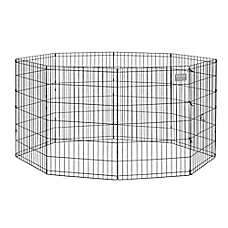Crates, Carriers, Gates and Kennels: What’s Best for My Dog?

In this Article
Your dog is your best friend, but sometimes you both need some alone time. These containment choices can help keep your dog corralled and comfortable:
Carriers
A sturdy carrier is a handy way to transport your dog and it doubles as a cozy hideout at home. When choosing a carrier, be sure it’s just big enough for your dog to stand up, lie down and turn around in.
Hard-sided
Constructed of lightweight but sturdy plastic, a hard-sided carrier makes a perfect portable den where your pet can feel safe. Line the carrier with a washable foam pad and maybe a blanket, for extra security and softness. Hard-sided crates are also ideal to contain your dog when you’re traveling by car.
Consider a hard-sided carrier if you are:
- Going on a road trip with your dog in a car
- Transporting your dog in an airline cargo hold
Soft-sided
Usually made of fabric, a soft carrier is a good option for toting a small dog across relatively short distances. It’s also the carrier of choice if you’re flying with your dog in the main cabin of an airplane.
Consider a soft-sided carrier if you are:
- Flying with your dog in the main cabin of an airplane
- just out and about and want to carry your small dog with you
Wire Crates
This option tends to be too big and not sturdy enough for transportation. But a wire crate is an affordable and easy way to keep a dog out of mischief if you have to leave your pet home alone for a little while. Make sure there’s enough room in the crate for your dog to move around comfortably. A pad or bed on the floor will keep your pet happy.
Consider a wire crate if you:
- need to be away from your dog for a few hours
- are crate training your dog
Kennels and pens
Think of this as a playpen for dogs. A sturdy metal or chain-link kennel or a metal, plastic or nylon pen is roomier than a wire crate (though not always as portable), which allows dogs to run around a little. They’re usually used outdoors.
Consider a pen if you:
- Need a temporary area to contain your dog that’s more portable than a crate
- Want to add additional lounging space to his crate or sleeping spot
- Want to include your dog in outdoor activities — but don’t want to give him the run of the yard
- Need to contain more than one dog
- Need to give your dog a safe environment to dry off after a bath or recovery from an injury
Gates
This is the canine version of a baby gate. These easy-setup temporary barriers can go up in a doorway or hallway, keeping your dog out of off-limits areas in your house.
Pressure-mounted gates
Consider a pressure-mounted gate if you:
- Want a simple solution that doesn’t require tools or hardware to set up
- Plan to move the gate from room to room
- Want to block off angled openings
- Have a dog who tends to squeeze through tight spaces
Hardware-mounted gates
Consider a hardware-mounted gate if you:
- Have a dog who tends to knock things over
- Don’t mind using hardware and tools to secure the gate to a solid door frame
- Don’t plan to move the gate often
- Need a gate at the top of a staircase
Free-standing gates
Consider a free-standing gate if you:
- Have a small to mid-sized dog
- Have a dog who won’t jump over or knock down obstacle
- Need a gate that’s easily portable
- Need your gate to span a wide entrance or have walls won’t support a pressure- or hardware-mounted gate
- Aren’t using your gate to block off a staircase


